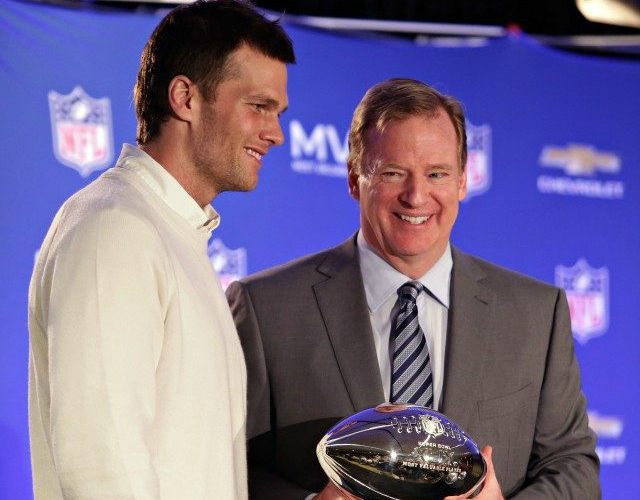<header class="articleheader" style="color: rgb(17, 17, 17); font-family: Georgia, serif; font-size: 16px; line-height: 22.4px;">[h=1]25 Ways the NFL Slimed Tom Brady[/h]
<figure class="figurearticlefeatured" style="margin: 0px;">

</figure>by DANIEL J. FLYNN27 Apr 2016197
</header>[h=2]From the investigator touting as truth the opposite of the testimony of the AFC Championship Game referee on the matter most salient to Deflategate to the league admitting ignorance of the Ideal Gas Law to Roger Goodell hearing the appeal on the fairness of the suspension Roger Goodell handed down, the NFL gives its fans myriad reasons to doubt its investigation into Tom Brady.[/h]Here are 25 of the ways in which the NFL railroaded the face of the league:
210
2
<figure class="figurearticlefeatured" style="margin: 0px;">

</figure>by DANIEL J. FLYNN27 Apr 2016197
</header>[h=2]From the investigator touting as truth the opposite of the testimony of the AFC Championship Game referee on the matter most salient to Deflategate to the league admitting ignorance of the Ideal Gas Law to Roger Goodell hearing the appeal on the fairness of the suspension Roger Goodell handed down, the NFL gives its fans myriad reasons to doubt its investigation into Tom Brady.[/h]Here are 25 of the ways in which the NFL railroaded the face of the league:
- Roger Goodell Called Ted Wells ‘Independent’—Until He Called Him His Lawyer
- The NFL Does Not Know the Pregame Pressure of the Game Balls
- The NFL Disregarded the Testimony of the Referee of the AFC Championship Game
- Wells Used Amateurish Photographic Trickery
- Wells Botched Basic Facts
- Wells Wishes Away Wildly Fluctuating Gauge Readings
- The NFL Employs Circular Science Calibrating the Gauges
- Wells Reading Between the Lines Always Benefits Incoming Thesis
- Wells Shielded NFL Correspondence by Citing Attorney-Client Privilege
- Wells Admitted an Employee Who Helped Write His ‘Independent’ Report Cross-Examined Brady
- Goodell Violated the Collective-Bargaining Agreement by Using Troy Vincent to Suspend Brady
- Goodell Heard the Appeal of His Own Decision
- Wells Created a False Impression That the Patriots Kept the Ball Handler from Follow-Up Interviews
- The NFL’s Rules Specify a $25,000 Fine for Ball Tampering
- Goodell Bizarrely Likened Slightly Deflated Footballs to Steroids
- The NFL Changed Its Punishment Rationale When the Wells Report Fell Apart
- The NFL Refused to Correct Its False Leaks
- Wells Employs Clear Double Standards
- The Refs Botched the Measurements by Gauging Colts Balls Later
- Rivals Egged on the NFL to Conduct a Sting
- The Colts Balls Tested Also Lost Significant Air Pressure
- Wells Flip-Flops on Whether to Rely on the Referee’s ‘Best Recollection’
- The NFL Never Tested Drops Air Pressure Prior to Deflategate
Jeff Kessler: Okay, so in all other NFL games generally, there is no testing at halftime at all, correct?
Troy Vincent: No, because we typically don’t have a breach with a game ball violation.
Jeff Kessler: Okay. And there is typically no testing after the end of the game regarding footballs, either, correct?
Troy Vincent: No, sir.
Jeff Kessler: So the only testing the NFL had in place was the testing before the game started as a routine matter.
Troy Vincent: Protocol, before the game.
Troy Vincent: No, because we typically don’t have a breach with a game ball violation.
Jeff Kessler: Okay. And there is typically no testing after the end of the game regarding footballs, either, correct?
Troy Vincent: No, sir.
Jeff Kessler: So the only testing the NFL had in place was the testing before the game started as a routine matter.
Troy Vincent: Protocol, before the game.
- Roger Goodell Refuses to Release Results of 2015 Spot PSI Testing
- The NFL Pleaded Ignorance on the Ideal Gas Law
Jeff Kessler: Okay. So prior to this game, okay, had you ever heard of the Ideal Gas Law?
Troy Vincent: No, sir.
Jeff Kessler: Do you know if anyone in the NFL Game-Day Operations had ever discussed the impact of the Ideal Gas Law in testing footballs?
Troy Vincent: Not with me.
Jeff Kessler: You had never heard of that?
Troy Vincent: I hadn’t.
The Patriots defeated the Colts 45-7 in last season’s AFC Championship Game. The evidence shows a similarly lopsided victory over Ted Wells, Roger Goodell, and the NFL—even though an appeals court this week ruled that the league “met the minimum Legal standards” in their pursuit of the four-time Super Bowl winner.Troy Vincent: No, sir.
Jeff Kessler: Do you know if anyone in the NFL Game-Day Operations had ever discussed the impact of the Ideal Gas Law in testing footballs?
Troy Vincent: Not with me.
Jeff Kessler: You had never heard of that?
Troy Vincent: I hadn’t.





